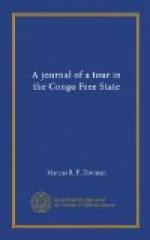The result was that I spent a most horrible night, for the mosquitoes were terribly hostile and evidently recognised a new European with some healthy blood. In the morning, my head, which I had had shaved in the Congo fashion, was covered with large bumps and face, neck, hands and wrists were all blotches. It was therefore with little appetite that I sat down to a breakfast of bread, dutch cheese, curious tinned butter and weak coffee without milk. Little however, did I think then that in six short months a Congo steamer would seem like a first class hotel, so entirely is everything altered by comparison.
[Illustration: CATARACTS AT LEOPOLDVILLE.]
CHAPTER III.
The Higher Congo.
Next day we make a formal call on Mr. Mahieu, Inspecteur d’Etat of the Congo State, whose headquarters are at Leopoldville. He is a very busy man with a multitude of duties, for the paternal system is continued all through the State and the most trivial matters are always referred to the highest official in the neighbourhood. As we are to lunch at the Residency, we do not stay long, but take a ride with Commandant and Mme. Sillye on four of the horses the former purchased at Dakar. Although a little stiff after their holiday of a month, they have not been otherwise affected by their sea voyage and two days in the train. Along the beach are many steamers charging and discharging and others on the slips being repaired or partly built. These steamers are all brought out in sections and put together on the beach. They are flat bottomed, are driven by stern wheels and only draw three or four feet of water. They all burn wood, and special depots are formed at intervals on the rivers where stores of this fuel are collected. Should however, a steamer run short, it is only necessary to stop and send the crew ashore with knives for the banks are lined with forest.
Leaving the beach we ride through avenues of palms and mango trees to higher ground, whence a beautiful view can be obtained of Stanley Pool. This is really a part of the river about sixteen miles wide, shut in by hills on each side, but its size is not apparent from the water itself, as a great number of islands cut the stream into numerous narrow channels. Towards the south, the river narrows again and at this point is the uppermost of the cataracts, the water hurling itself against the rocks in its efforts to escape and recoiling in spray high into the air. From just below Leopoldville all the way to Matadi, the river indeed rushes down narrow gorges, but above, for nearly a thousand miles, it is navigable for steamers. On a hill above the rapid, is a large tree under which Stanley pitched his tent and which still bears his name.




